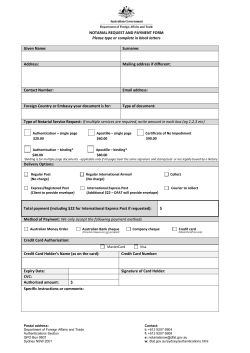
Chem 352 - Fall 2014 Quiz 3 R
Name __________________________________ Key ! Chem 352 - Fall 2014 Quiz 3 R = 8.314 J/(mol•K) = 0.08206 (L•atm)/(mol•K) ! 1. Myoglobin (Mb) and hemoglobin (Hb) are both oxygen binding proteins. a. Though both Mb and Hb bind oxygen, they do so for different reasons. For mammals, describe the role that each protein performs when binding oxygen. Mb: Myoglobin’s role is to bind and store oxygen in the tissues until needed. It has a heme group cofactor which gives the protein a red color, which in turn can give muscle tissue a red color as well. Hb: Hemoglobin’s role is to bind oxygen in the lung and then transport it through the blood to the tissues. There it releases it, often to an awaiting myoglobin molecule, which in turn binds and stores it until needed. For this to work, the hemoglobin must have a lower affinity of oxygen in the tissues than myoglobin does. Hemoglobin also contains heme groups, which why blood is red b. On the graphs shown to the right, sketch and label the oxygen binding curves, fraction bound (Y) vs. partial pressure of oxygen in torr (pO2), for Mb with a P50 of 10 torr and Hb with a P50 of 30 torr. Be sure to label the axes. Y 12/12 1.1 1.0 0.9 0.8 Mb 0.7 0.6 0.5 Hb 0.4 Hb at pH 7.2 0.3 0.2 0.1 0.0 0 10 20 30 40 50 60 70 pO2 (torr) 80 90 100 110 120 c. Given the pO2 is 100 torr in the lungs on 26 torr in the tissues, explain how the differences in the binding behaviors for Mb and Hb shown in the graphs above best suites each oxygen binding protein to the roles you described in part a. When in the lung, hemoglobin will become nearly 100% saturated with oxygen, but as travels out to the tissues, where the partial pressure of O2 is lower, hemoglobin’s binding affinity for oxygen falls off more rapidly than myoglobin’s. This allow it to more readily pass of the oxygen off to the awaiting myoglobin molecules. d. During time of heavy exertion, the pH of the blood out in the tissues may drop by a couple of tenths of a pH unit. On the graph above, sketch and label a second binding curve for Hb that illustrates the effect that a drop in the pH from 7.4 to 7.2 will have on the Hb’s oxygen binding behavior. e. Explain why this behavior would allow for Hb to deliver more O2 to the tissues? The lowering of the pH leads to protonation of groups on the hemoglobin, which leads to the formation of salt bridges (charge/charge interactions) that stabilize the deoxy (tense) state for hemoglobin. This will increase the apparent P50 for Hb and shift its sigmoidal binding curve further to the right. this will allow the hemoglobin to off load even more oxygen to the awaiting myoglobin when it reaches the tissues. Chem 352 13/12 Quiz 3 Fall, 2014 2. Fumarase is an enzyme that catalyzes one of the reactions in the citric acid cycle in which fumarate is converted to L-malate. Lyase a. What class of enzyme-catalyzed reaction is this? _______________________________________ 2.0 The initial rate (vo) for the fumarase reaction was measured as a function of the fumarate concentration. The fumarase concentration used in these experiments was 5.0 nM. The results of this experiment are shown in the graph to the right. 1.8 1.6 1/v0 (s/µM) 1.4 b. What is the name for this type of plot? Lineweaver-Burke Plot __________________________ KM = 1.2 1.0 0.8 0.6 0.4 −1 −1 = = 0.24 mM x − intercept −4.0 / mM Vmax = 0.2 -4 -2 0 2 4 1 1 = = 3.33 µM/s y − intercept 0.30 s/µM 6 8 10 12 14 1/[fumarate] (1/mM) c. How may fumarate molecules does fumarase convert to L-malate per second, when fully saturated 666 molecules per second with fumarate? (Show calculations)__________________________________________________ This is given by the turnover number, or kcat, k cat = Vmax ⎡⎣ E ⎤⎦ total ; k cat = 3.33 µM/s 3.33 x 10 −6 M/s = = 666 / s 5.0 nM 5.0 x 10 −9 M No d. Under these condition, is fumarase displaying catalytic perfection? _________________________ What is your evidence for this claim? This is determined by comparing the catalytic efficiency, k cat KM = k cat KM , to its theoretical maximum, 108 1/M•s. 666 / s 666 / s = = 2.64 x 106 1/M•s, which is << 1 x 108 1/M•s 0.25 mM 0.25 x 10 −3 M e. What does it mean for an enzyme to be catalytically perfect. k The theoretical maximum value for cat of 108 1/M•s is imposed by the rate that the substrate molecules K can diffuse into the active site of theMenzyme. Since there is nothing that be done to the enzyme the enzyme to increase the reaction rate beyond this point, we say that the enzyme as attained catalytic perfection. f. Meso-tartrate is a competitive inhibitor of fumarase. On the graph shown above, show what effect this inhibitor should have on the kinetics of this reaction. A competitive inhibitor is one that competes with the substrate for binding to the active site of the enzyme. It has no effect on Vmax, but increases the apparent KM. 25/25
© Copyright 2025


















